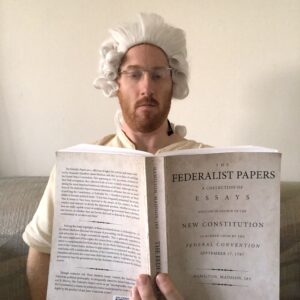 While the Constitutional Convention of 1787 produced the document we now recognize as the Constitution of the United States, it was not automatically (or enthusiastically) endorsed by all the founding colonies. The Federalist Papers are a collection of 85 essays written in favor of ratifying the Constitution, penned by Alexander Hamilton (first Secretary of the Treasury), James Madison (fourth President of the United States), and John Jay (first Chief Justice of the Supreme Court).
While the Constitutional Convention of 1787 produced the document we now recognize as the Constitution of the United States, it was not automatically (or enthusiastically) endorsed by all the founding colonies. The Federalist Papers are a collection of 85 essays written in favor of ratifying the Constitution, penned by Alexander Hamilton (first Secretary of the Treasury), James Madison (fourth President of the United States), and John Jay (first Chief Justice of the Supreme Court).
Written nearly 250 years ago, the language of these essays is immediately tough to decipher and yet also poetic and profound. Many of the passages required multiple readings (and sometimes a dictionary) in order to comprehend their meaning. Despite these moderate hurdles, the political knowledge espoused by these three men (mostly Hamilton and Madison) is truly breathtaking—their knowledge of history, commerce, and law puts most modern politicians to shame. They are at their best when taking a broad view of human affairs, their general reflections both wise and quotable, and I found many passages that felt prescient of our current society. The trade off between the need for government and the desire for liberty, for example, or the knowledge that it is “the nature of war to increase the executive at the expense of the legislative authority.”
Some of the topics covered in these essays include the division of powers, taxation, and the organization of a national defense and the necessity of a powerful navy. The authors attack these topics with vigor, arguing that the colonies would be stronger together in every instance as opposed to quarreling amongst each other and taxing each other’s imports and exports. One of the most famous essays—#10 (written by Madison)—explains that while citizens may fear that a larger government would impede upon their liberty, extending the sphere would “take in a greater variety of parties and interests,” and would make it “less probable that a majority of the whole will have a common motive to invade the rights of other citizens.” Indeed, essay #7 (written by Hamilton) concludes with the statement “divide et impera (divide and command) must be the motto of every nation that either hates or fears us.”
Something of note was the absence of an essay about slavery. Given that Madison was a slave owner and Hamilton an abolitionist, this is exemplary of the contention around the issue at the time. The term ‘federalist’ is appropriate as it constitutes the compromises required to get the Constitution written and eventually ratified. “It is a matter both of wonder and regret, that those who raise so many objections against the new Constitution should never call to mind the defects of that which is to be exchanged for it,” Madison writes in essay #38. “It is not necessary that the former should be perfect; it is sufficient that the latter is more imperfect.” Compromise was indeed the spirit of the Constitution.
I found these essays to be fascinating and informative despite the difficultly of the language. These men write about infinitely complex issues and do their best to project into the future where they thought their fledging society would go. While they may not have been very accurate, and would surely be appalled at the gargantuan size of our federal government today, we should be thankful they wrote these essays for the public consideration (and for the legislatures who ultimately ratified our Constitution).
The final essay ends with a quote from the Scottish philosopher David Hume: “To balance a large state or society, whether monarchical or republican, on general laws, is a work of so great difficulty, that no human genius, however comprehensive, is able, by the mere dint of reason and reflection, to effect it. The judgments of many must unite in the work; experience must guide their labor; time must bring it to perfection, and the feeling of inconveniences must correct the mistakes which they inevitably fall into in their first trials and experiments.”
The knowledge stored in these pages is profound and insightful and undoubtedly swayed many, including myself, towards the conclusion that the states of America are stronger united than divided.


